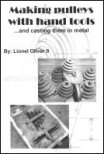Part 1: I need pulleys - Part 2: Bet you can't cast just one - Part 3: What a messy lathe you have |
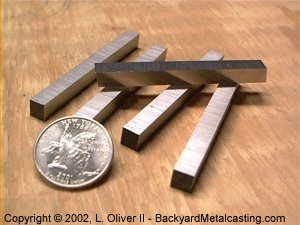 |
I had ground a cutter bit from another thread cutting tap but decided to buy some real lathe tool material. The cheapest I could find were these for $3.95 each. The NY quarter is for size comparison. |
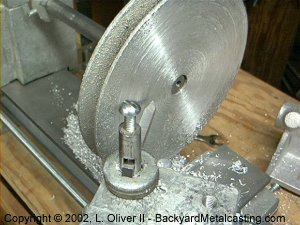 |
As you can see I attached a pulley to the boring bar to "face it off" and clean up the V-groove. Yes! that's right, the lathe is complete enough to do that! The surface of the pulley was a bit uneven so at first only part of it was being touched by the cutter tool. And it was pretty jerky cutting also. The bit "snagged" and dug in a couple of times, I must have been moving it in too quickly. I had the lathe on the second to lowest speed at this time. However I turned it up to the second to highest speed and cutting was a lot smoother. In the lower right corner you can see part of the tailstock casting. |
The pulley is right on the end of the bar which caused some problems in the form of vibration. I eventually moved it closer to the headstock and the results were much better.
|
 |
Here you can see I'm a little further along and the actual facing-off is taking place. This tool leaves a fairly rough cut, but then again the book said it was a "roughing out tool." |
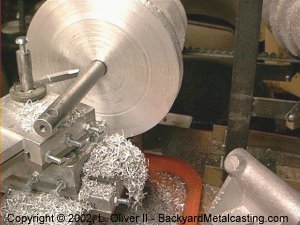 |
This is a despicable mess. The shavings were actually clogging the carriage making it difficult to move it to make the cuts. There's the tailstock casting in the lower right corner. |
 |
The back of the pulley is done and I flipped it over to face-off the front. Here's how it looked before I began. As you can see I moved it further back on the bar. |
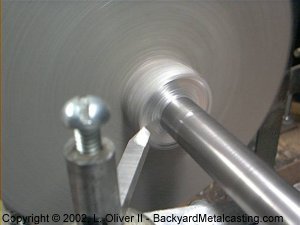 |
Here I'm facing-off the pulley's hub. This side of the pulley took me half the time of the first 'cause I was finally "getting the hang" of using this lathe contraption. |
 |
Now that the single groove pulley is done I moved onto the stepped pulley and began facing off the back. You can see the concentric ring moving out from the center as the tool cuts and I move the cross slide backward. These pulleys are solid all the way through unlike the commercial ones which are hollowed out in the back. To save weight I was going to bore the back out. I had followed the instructions in an old Popular Mechanics article about grinding boring bits from regular drill bits. I happened to use a thin drill bit and it was working until it violently snapped in half and flew off to who knows where. I'm not even gonna look for it... Wear safety glasses! |
 |
Here are the two finished pulleys on the lathe. You can see the orange plastic lunch tray I put under the lathe bed to catch most of the shavings. The V-Grooves
I didn't really have to do any machining in the V-grooves since they were cast in place from the start. So as they were spinning in the lathe I simply moved a file along the grooves to smoothen the sand texture away. Quick and easy (the easiest part!). |
I'm happy to say that I have succeeded in my goal of making well balanced, usable pulleys with hand tools and the lathe was just a nice "extra" or "perk" which I used to "fancy-up" the pulleys. But more importantly, these suckers were FREE! Eat that all you metalworking supply stores! |
 |
Here's a closer look at the pulleys. The flat pulley has a ring machined around the edge just for looks. The surface isn't the smoothest but for someone who's never touched a lathe before It's a start. I'll keep practicing. I need to machine one more step pulley and I'll be able to replace all the lathe's main pulleys. I was planning to cast the pulleys in bronze and machine them for a really original look, but Chipmaker (a.k.a. Roy Hauer check out his site) publicly mentioned doing that for his drill press in the hobbicast forum. So in a sense he beat me to it! |
 |
This is just another picture of the shavings from those two pulleys. The step pulley is nice and snuggled up in it's nest... |
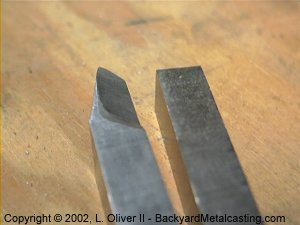 |
Here's a look at my cutting bit. It's a right hand bit ground according to instructions in the book "How to run a lathe" that I got from Lindsay Pubs.. I ground it on an bench grinder using the side of the wheel for most of the work. It looks pretty close to the illustration to me. If anyone has comments or advice about this feel free to e-mail me, thanks. |
Part 1: I need pulleys - Part 2: Bet you can't cast just one - Part 3: What a messy lathe you have |
